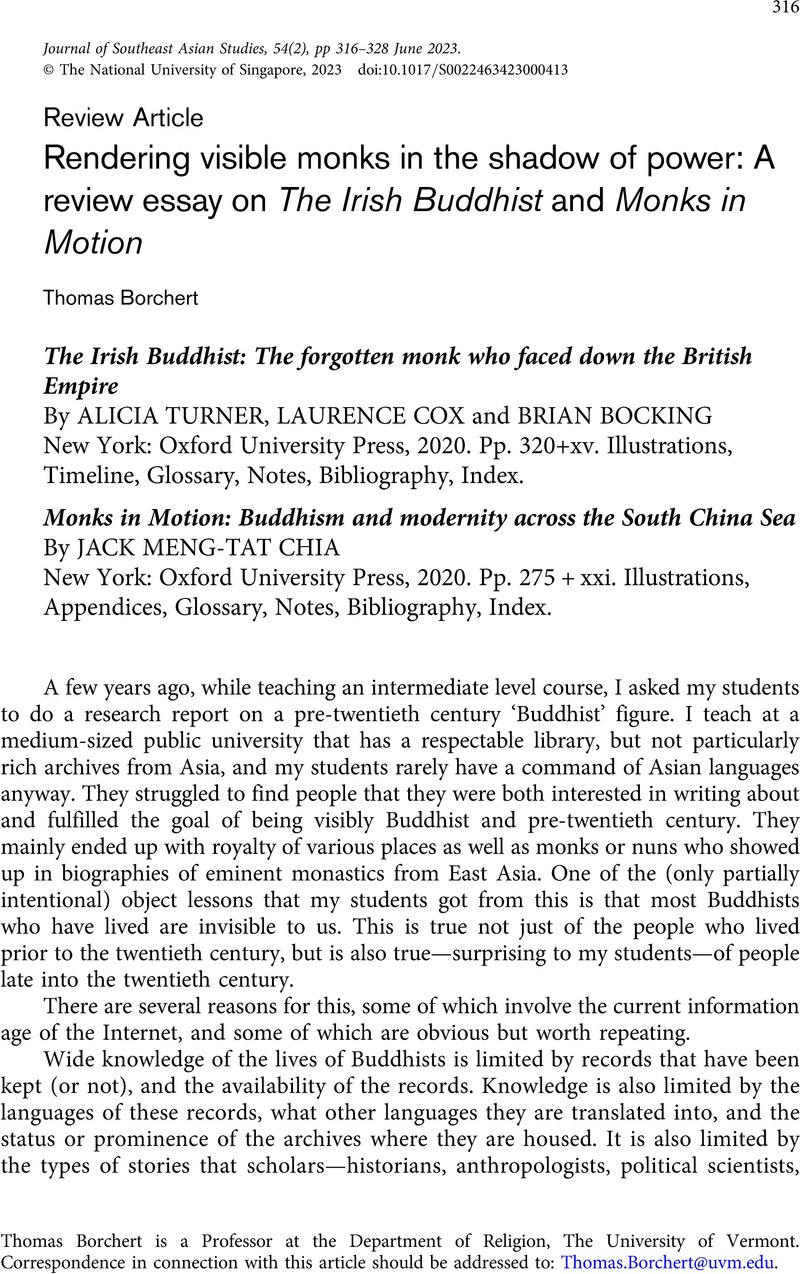No CrossRef data available.
Published online by Cambridge University Press: 28 July 2023

1 Turner, Alicia, Cox, Laurence and Bocking, Brian, The Irish Buddhist: The forgotten monk who faced down the British Empire (New York: Oxford University Press, 2020), p. 23CrossRefGoogle Scholar.
2 Turner et al., The Irish Buddhist, p. 16.
3 Ibid., pp. 166–7.
4 Ibid., pp. 14–15.
5 Chia, Jack Meng-Tat, Monks in motion: Buddhism and modernity across the South China Sea (New York: Oxford University Press, 2020), p. 3CrossRefGoogle Scholar.
6 Ibid., p. 121.
7 Ibid., p. 157.
8 For example, see ibid., p. 51.
9 Ibid., p. 126.
10 Blackburn, Anne, Locations of Buddhism (Chicago: University of Chicago Press, 2010)CrossRefGoogle Scholar; Braun, Erik, The birth of insight: Meditation, modern Buddhism, and the Burmese monk Ledi Sayadaw (Chicago: University of Chicago Press, 2016)Google Scholar; Kemper, Steven, Rescued from the nation: Anagarika Dharmapala and the Buddhist World (Chicago: University of Chicago Press, 2015)Google Scholar. We might also include the collected volume of short essays on lives, Buddhist, Figures of modernity in Buddhist Asia, ed. Samuels, Jeffrey, McDaniel, Justin and Rowe, Mark (Honolulu: University of Hawai‘i Press, 2016)Google Scholar.
11 Chia, Monks, p. 47.
12 Ibid., p. 3.
13 Ibid., pp. 158–9.
14 Turner et al., The Irish Buddhist, p. 65.
15 Kirichenko, Alexey, ‘The Thathanabaing project: Monastic hierarchies and colonialism in Burma’, in Theravada Buddhism in colonial contexts, ed. Borchert, Thomas (London: Routledge, 2018)Google Scholar; Turner, Alicia Marie, Saving Buddhism: The impermanence of religion in colonial Burma (Honolulu: University of Hawai‘i Press, 2014)CrossRefGoogle Scholar.
16 Turner et al., The Irish Buddhist, p. 175.
17 See, for example, ibid., p. 55.
18 Such as those described in Frost, Mark Ravinder, ‘“Wider opportunities”: Religious revival, nationalist awakening, and the global dimension in Columbo, 1870–1920’, Modern Asian Studies 36, 4 (2002): 937–67CrossRefGoogle Scholar. For a recent discussion complicating the way we think of networks, see Blackburn, Anne M., “Circulations” in Routledge handbook of Theravada Buddhism, ed. Berkwitz, Stephen and Thompson, Ashley (New York: Routledge, 2022)Google Scholar.
19 Chia, Monks, pp. 88–9.
20 This is a point Chia is explicitly writing against. See ibid., pp. 7–8.
21 Turner et al., The Irish Buddhist, p. 23.